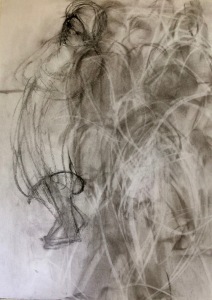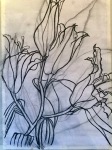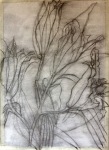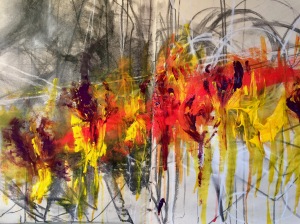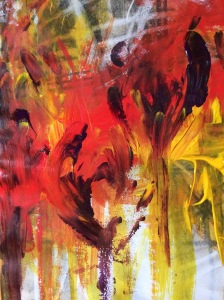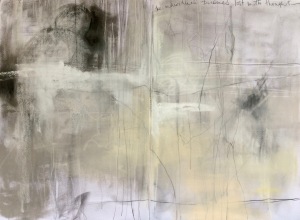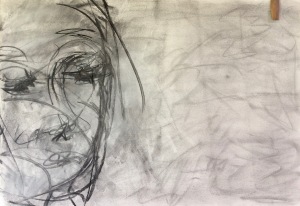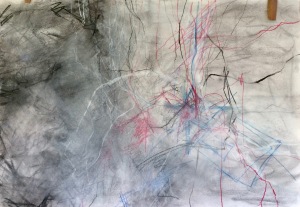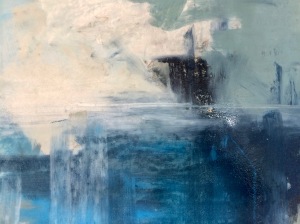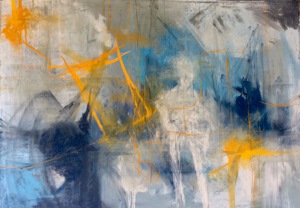ASSIGNMENT 5
“Review the project work you’ve completed for this part of the course and then produce a drawing that needs a period of time to elapse during its production.”
This post is going to be rather long with over 70 images. It has evolved over a period of over two months.
The assignment piece I have decided on is titled ‘Thought Lines’. I have tried to draw ‘the inner landscape of changing thought’ and it has emerged out of concentrated exploration of thought, creativity and ideas in contrast to the stationary figure of the reflective individual.
It took me quite some time to decide what was actually required for this final assignment. A drawing emerging over a period of time could be many things and the introduction to the section made a point of “avoiding second-hand illustration of effect “. What confused me were the illustrations given of the visual diary of a pregnancy which seemed to me to be just that. Almost every idea that came to me seemed to be an illustration of effect.
The concept for this work arose out of Project 1. One aspect of my work in that project – ‘A Changing Scene’ – explored the contrast between figures which were on the move and figures which were stationary yet absorbed in new concepts and creative ideas. All the movement was happening in thought and yet to the seeing eye, there was no movement at all.

I finished that first project with an unfinished image and I was dissatisfied with an unresolved idea. These drawings of ‘the thought process’ as swirling lines seemed so very obvious. The question of how to draw ‘thought’ and the concept of the stationary element of time elapsing as thought and ideas were moving and developing began to fascinate me.
That was the starting point for the assignment – to explore the concept of ‘silent listening’, ‘the stationary aspect of moving thought’ or more simply ‘thought lines’. These titles may not be a right description of what I’m trying to find but it’s the best I can see at the moment. It’s been fascinating to explore this idea of time and movement because I’ve come to see that silence and the stationary figure are also elements of both time and movement. These elements are sadly hard to find in our society today.
The following description and images show the period of time which elapsed as I explored many different ideas before the final image emerged.
The development of the idea…
As I’ve explained, my obsession with the concept of stationary movement arose from the first project. With the stationary figure I tried to create a sense of the movement of thought with lines and texture using charcoal and pastels. I found this unsatisfactory and so obvious – the idea of swirling thought descending from on high!
So I began to work and experiment in a large A1 homemade sketchbook I’d sewn together using old sheets of paper. This was a good vehicle for me – it was not precious and the surface would take anything I did! Still thinking about depicting thought by lines, I worked with gestural marks, very free and experimental. I was still working with the figure at this stage.

I then took the idea of the gestural marks on their own, and worked with a more abstract image. This was running in parallel with my Parallel Project on Abstraction. I was also experimenting with a different mark using shapes. As I worked with this image, the figure began to emerge again but in an abstract form. I was thinking here about ‘submergence’ – the individual being submerged in thought.





At this stage, the exploration took a different turn. Rather than concentrating on expressing the movement of thinking and ideas, I decided to explore the stationary aspect of ‘thinking’. This meant going back to the figure and exploring the face. I was thinking of the process of an internal activity of the mind and worked to see how this can be expressed. As I was doing this I was thinking about Matisse’s wonderful painting of “The Absentminded Reader”, probably not what I was trying to bring into my work but for me, it is a wonderful image of the stationary figure absorbed in thought. I was working on a sightless facial image where all the activity was happening in the mind.
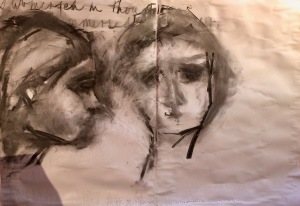

Some time elapsed as I worked on other projects.
Returning again to this subject, I was not satisfied that I’d reached any outcome. Several ideas had been left hanging in the air and I didn’t feel impelled to pick any of them up. But still the idea wouldn’t leave me!
So I took a completely new tack…I went the obvious route! Perhaps, I said to myself, you are being too obtuse! Just keep it simple and accessible! Over the period of the next few weeks I worked with some drawings of an emerging flower from the bud, exploring the idea of the emerging thought! I took the lily and started the work with the outline sketch of the closed bud. I worked in charcoal and after the first drawing I rubbed the lines back with a cloth so that only the impression was left.
After about a week the buds began to open. The process took longer than normal as the flowers were kept in a cold studio. Making sure to keep the centre stalk always the same I then drew the new shapes of the flowers. The leaves were all beginning to fall downwards. I was still working in charcoal but found when I repeated the rubbing down process like the first image, the two images were indistinguishable. This was a shock and so I had to draw the flowers all again. This time I rubbed them back very carefully so that both of the drawings were visible. It was interesting to look at them at this stage because there was a definite impression of the flowers moving.
It took longer for the third drawing because of the temperature in the room but finally the flowers opened further, in fact were at the final stage. I repeated the process as before but didn’t rub the lines back.

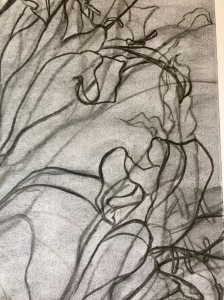

This piece of work gave me a real sense of the stationary in contrast to the indistinguishable movement of the opening flower. However, I felt that the final assignment work needed to be more than just ‘from bud to flower’, This felt too simplistic in view of the ideas I’ve been grappling with during this section and my parallel project.
As I reviewed the process of this image of the lily I saw that it was not about an emerging flower. It was actually a development from the work I’d been doing about mental space and the movement and change that happens in the mental realm with ideas. All during this time I’d been working on the daily diary of images for the parallel project and it occurred to me that some of my thinking about this assignment piece were evident in some of the images.
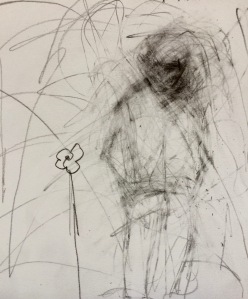
All of this work had been happening over a period of about 5 weeks. I was at the stage of needing the final image for the assignment and so I went back to experimenting and began again to push further the ideas. I was still searching for the creative imagery of expanding thought. In order to push through boundaries of thinking, I decided to explore the idea of exchanging objects that we see into thoughts. To get a different viewpoint I experimented with colour based on a vase of tulips in the studio. This was very experimental, applying the colour with my hands. I immediately rejected this idea but in just doing something so different I was able to break down a mental barrier. Still not there yet…!
However, having done work which was very ‘noisy’ in this last set of images, it was becoming clearer to me that the thought process and the energy of ideas was a silent process and so the image needed to suggest depth, quietness and listening. This was very different to the initial images of swirling lines. So I went back to the sketchbook and began to work on these qualities. The question of the thinking figure remained…whether to leave it in or out.

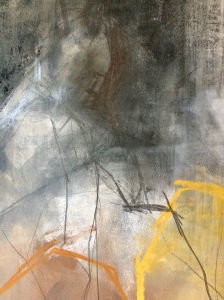
In this work the image is there to start but then becomes submerged in the thought process. The imagery of the thought process always seemed to end up as some mysterious landscape which wasn’t what I was searching for. My mind kept returning to the solitary figure…
So I went back to do some more work with the solitary figure. Was this figure essential to the image of ‘expanding thought’?
In all of this concentrated thinking and searching for the resolution of the idea, it occurred to me that this idea of creating work which depicts ‘thought’ was not a new idea for me but had been with me for several years and so I decided to go back to some work which I’d done some years ago, to try to get a new view. I first looked at a painting I’d done of ‘reverie’ and could see how just the solitary figure could encapsulate the individual’s absorption into thought. The choice of the color and tones as well as the stance of the figure expressed the ideas. Nothing else was really needed.

I then returned to two images I’d painted previously of ‘the child thought’, thought which was totally in the ‘now’ – instant colour, instant connection.


Looking at these past paintings consolidated my ideas. It highlighted the difference between the child thought and the adult thinking which was far more complex and included a ‘landscape’ of experience and memories. At this stage I felt at last to be making progress in finding the image I was searching for.
Focus was now on the figure. Starting from the original figure in project 1 I played around with different figure poses.


It became obvious that the inclusion of the figure immediately set up a narrative. But because I couldn’t yet see what the final image would be I decided to work with and without the figure either as a full figure or just a face. Continually at the back of my mind were all of the images in my daily diary (parallel project) which had featured so much exploratory work on line. And so the final image was beginning to emerge!
In this final stage (this work has spread over several months and reflects all of the work for Part 5) I worked with just the face to begin with. This was an interesting stage because as the image began to emerge, it actually became a self-portrait and I realized that what I was drawing was my own emerging thought process. The struggle and search over so many weeks was linked to understanding how thought emerges, how we bring our deepest thoughts and ideas into a visual reality. This was a complete revelation for me and the work became very personal.
In the sketchbook I created an image of a time line to suggest the passage of time. I then began to work on the emerging face, drawing with charcoal and pastel, then rubbing it back, repositioning the eyes, then rubbing back, allowing the image to emerge from the surface. I then began to work up the thought process using the experimenting from the daily diary on the expressive use of line. All the time I was thinking deeply about the creative process as new ideas emerge.

By this stage I had researched the drawings of Frank Auerbach and his method of allowing portrait images to emerge from the surface by constant scraping off of paint, layering of paint or obliterating drawing lines. This concept fitted well with where I was with finding a resolution to my struggling to depict the changing nature of thought on the individual. I felt the point had now come to gather up all of the experimentation from the previous months and discover the image I knew must be there.
This resulted in two final pieces.
To begin I covered the paper in charcoal and random marks and then with the charcoal began to ‘find ‘ the face on the paper….drawing, rubbing back, drawing, rubbing back, each time noticing the changes in the face in line with changes to thought. This was a fascinating step and I literally watched as the face emerged. There was not preconceived idea here – I was the viewer (Roland Barthes would have been happy!).

I then worked on the ‘thought lines’. This pencil and charcoal work echoed the experiments I’d done for the parallel project in my daily diary. Tara Geer and Christine Hiebert, both artists working with line, were in my thought as I worked to express the many layered, uncertain, sometimes jumbled, sometimes clear, searching sense of silent, moving thought.

The second of the two assignment pieces focused more on the concept of an inner world of thought and ideas. In this, the figure or figures (there are 3) become completely immersed in creativity and thought lines.
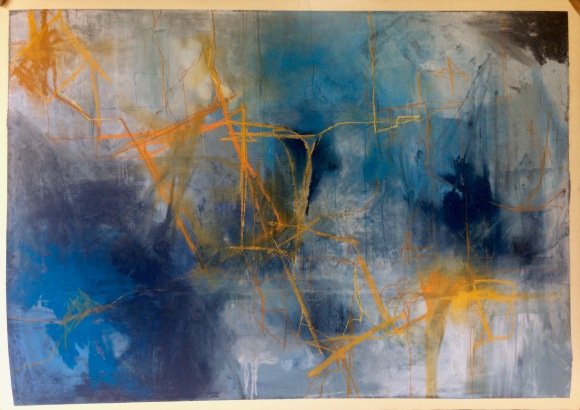
Sections of the image:





